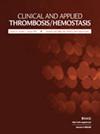Challenges to Laboratory Monitoring of Direct Oral Anticoagulants
IF 2
4区 医学
Q2 HEMATOLOGY
引用次数: 0
Abstract
Direct oral anticoagulants (DOACs) exert anticoagulation effect by directly inhibiting Factor Xa (rivaroxaban, apixaban, and edoxaban) or thrombin (dabigatran). Though DOACs are characterized by fixed-dose prescribing and generally do not require routine laboratory drug-level monitoring (DLM), circumstances may arise where the DLM may aid in clinical decision-making, including DOAC dose adjustment, anticoagulant class change, or decisions to withhold or administer reversal agents. We review the current literature that describes high-risk patient groups in which DLM may be beneficial for improved patient anticoagulation management and stewardship. The review also summarizes the limitations of conventional coagulation testing and discuss the emerging utility of quantitative methods for routine and rapid emergent evaluation of DOAC drug levels—in particular, the Anti-Xa activity to detect Factor Xa Inhibitors (rivaroxaban, apixaban, and edoxaban). Both technical and regulatory barriers to widespread DLM implementation are limiting factors to further clinical research that must be overcome, in order to propose universal DOAC DLM strategies and provide clinical-laboratory correlation to formally classify high-risk patient groups.实验室监测直接口服抗凝药面临的挑战
直接口服抗凝剂(DOAC)通过直接抑制 Xa 因子(利伐沙班、阿哌沙班和依度沙班)或凝血酶(达比加群)来发挥抗凝作用。虽然 DOAC 的特点是固定剂量处方,一般不需要常规实验室药物水平监测 (DLM),但在某些情况下,DLM 可能有助于临床决策,包括 DOAC 剂量调整、抗凝剂类别变更或暂停或使用逆转剂的决策。我们回顾了当前的文献,其中描述了 DLM 可能有助于改善患者抗凝管理和指导的高风险患者群体。该综述还总结了传统凝血检测的局限性,并讨论了用于常规和快速紧急评估 DOAC 药物水平的定量方法的新兴效用,尤其是检测因子 Xa 抑制剂(利伐沙班、阿哌沙班和埃多沙班)的抗 Xa 活性。广泛实施 DLM 的技术和监管障碍是进一步临床研究的限制因素,必须加以克服,以便提出通用的 DOAC DLM 策略,并提供临床-实验室相关性,对高风险患者群体进行正式分类。
本文章由计算机程序翻译,如有差异,请以英文原文为准。
求助全文
约1分钟内获得全文
求助全文
来源期刊
CiteScore
4.40
自引率
3.40%
发文量
150
审稿时长
2 months
期刊介绍:
CATH is a peer-reviewed bi-monthly journal that addresses the practical clinical and laboratory issues involved in managing bleeding and clotting disorders, especially those related to thrombosis, hemostasis, and vascular disorders. CATH covers clinical trials, studies on etiology, pathophysiology, diagnosis and treatment of thrombohemorrhagic disorders.

 求助内容:
求助内容: 应助结果提醒方式:
应助结果提醒方式:


